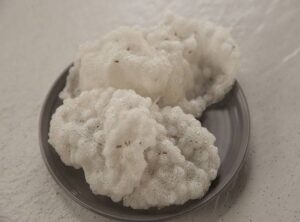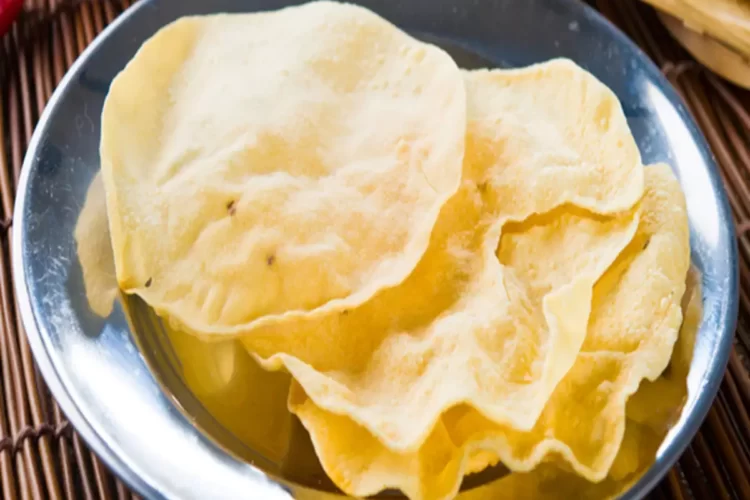Sabudana papad is a type of Indian snack that is made using sabudana (also known as tapioca pearls), spices, and sometimes herbs. It is a popular snack in parts of India, particularly in the western states of Maharashtra and Gujarat.
To make sabudana papad, sabudana is soaked in water until it becomes soft, then drained and mixed with spices like cumin, red chili powder, and salt. This mixture is then spread out into thin discs and dried in the sun until it becomes crispy.
It is typically served as a snack or appetizer, and it can be eaten on its own or with chutneys and dips. It is a crunchy and flavorful snack that is enjoyed by many people in India. However, it is important to note that sabudana papad is a high-carbohydrate snack and should be eaten in moderation as part of a balanced diet.
Ingredients for sabudana papad
- 1 cup sabudana (tapioca pearls)
- 2 cups water
- 1/2 teaspoon salt (or to taste)
- 1/2 teaspoon red chili powder
- 1/2 teaspoon cumin powder
- A pinch of asafoetida (hing)
- Oil for greasing the tray
Instructions for sabudana papad
- Rinse the sabudana in cold water a few times until the water runs clear.
- Soak the sabudana in 2 cups of water for at least 2-3 hours, or until it becomes soft and pliable. Drain any excess water.
- In a mixing bowl, combine the soaked sabudana with salt, red chili powder, cumin powder, and asafoetida. Mix well to combine.
- Grease a large tray or plate with oil.
- Take a small amount of the sabudana mixture and spread it out thinly and evenly onto the greased tray. Repeat with the remaining mixture.
- Dry the sabudana papads in the sun until they become completely dry and crispy. This may take 2-3 days, depending on the weather conditions.
- Once the sabudana papads are completely dry, carefully peel them off the tray and store them in an airtight container.
Serving suggestions
- Serve with mint or coriander chutney, sweet and sour tamarind chutney, or tomato ketchup.
- Use the sabudana papad as a base to make chaat – a popular Indian street food. Top the papad with boiled potatoes, chickpeas, chopped onions, tomatoes, and chutneys, and sprinkle some sev (crunchy noodles) on top.
- Crush the sabudana papad and use it as a crunchy topping for salads, soups, or vegetable curries.
- Serve the sabudana papad as a side dish with your favorite dal (lentil curry) or vegetable dish.
- Pack the it as a snack for picnics or road trips, as they are easy to store and transport.
- Enjoy the sabudana papad with a cup of hot tea or coffee as an evening snack.
Tips and variations
- Rinse the sabudana well before soaking to remove any excess starch, as this can cause the papads to stick to the tray.
- Use a non-stick tray or apply a generous amount of oil to the tray to prevent the papads from sticking.
- Spread the mixture thinly and evenly onto the tray, as thicker papads take longer to dry and may not become as crispy.
- Keep the tray in a dry and sunny spot to allow the papads to dry properly.
- Add other spices and herbs such as coriander powder, turmeric powder, or dried mint leaves for additional flavor.
- You can also add finely chopped onions, green chilies, or grated coconut to the sabudana mixture before spreading it onto the tray.
- Instead of making plain sabudana papads, you can also add a layer of sesame seeds or crushed peanuts on top of the mixture before drying it.
- For a tangy flavor, you can sprinkle some amchur powder (dried mango powder) or squeeze some lemon juice on top of the papads before serving.
FAQs
Q: How long does it take to dry sabudana papad?
It can take 2-3 days to dry sabudana papad in direct sunlight, depending on the weather conditions. If you don’t have access to sunlight, you can also dry them in an oven at a low temperature (around 150-170°F) until they become crispy.
Q: Can I use instant sabudana to make papad?
It’s best to use regular sabudana for making papad, as instant sabudana may not have the right texture or consistency.
Q: Can I store it for a long time?
Yes, you can store sabudana papad in an airtight container for several months. Make sure to keep them in a cool, dry place to prevent them from becoming soft or stale.
Q: Can I make it without spices?
Yes, you can make plain sabudana papad without adding any spices. However, adding spices like salt, red chili powder, and cumin powder can enhance the flavor and make them more enjoyable to eat.
Q: How do I prevent sabudana papad from sticking to the tray?
To prevent sabudana papad from sticking to the tray, use a non-stick tray or apply a generous amount of oil to the tray before spreading the mixture. You can also use parchment paper or plastic wrap to line the tray and prevent sticking.
Nutrition
Here is the approximate nutritional information for 1 serving (30g) of sabudana papad:
Calories: 120
Fat: 2g
Carbohydrates: 25g
Protein: 1g
Fiber: 1g
Sugar: 0g
Sodium: 100mg

You Might Also Like:
- Paneer do pyaza recipe
- Mushroom Pakoda recipe
- chicken chatpata recipe
- Oreo Mug Cake Recipe
- Paneer Dum Biryani Recipe
- Aloo paneer paratha recipe
follow us on Instagram, Facebook, and youtube

